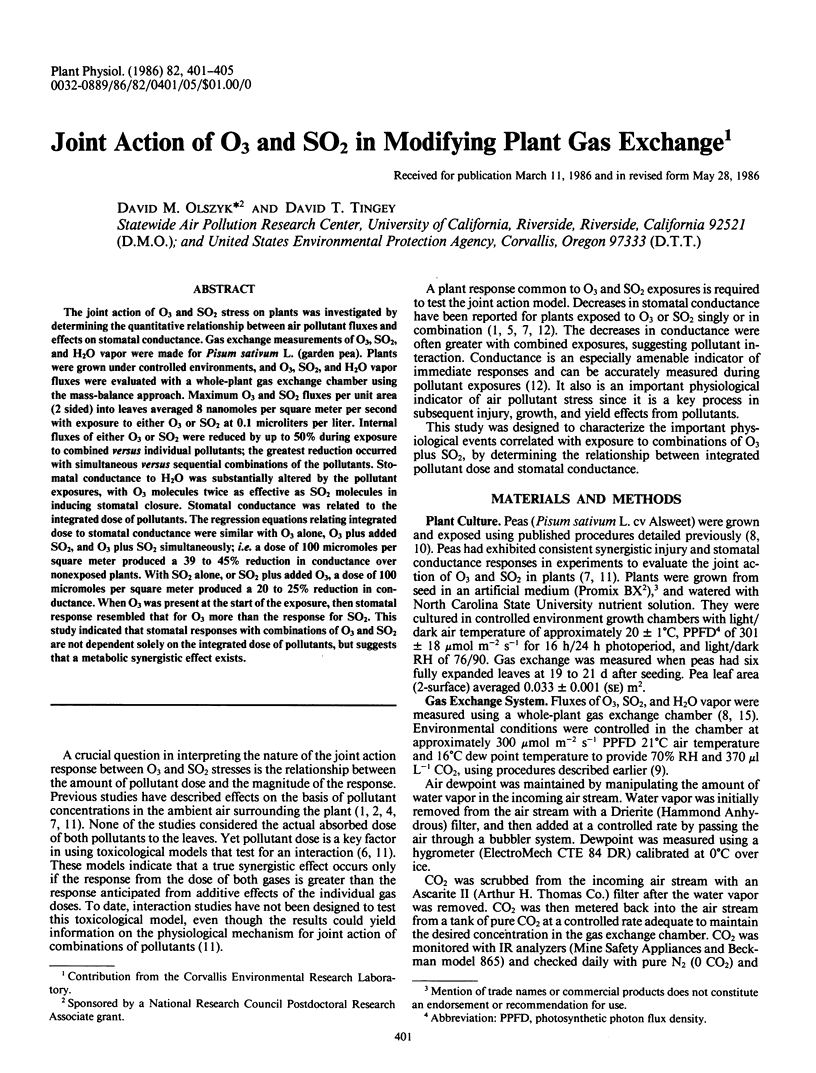Abstract
The joint action of O3 and SO2 stress on plants was investigated by determining the quantitative relationship between air pollutant fluxes and effects on stomatal conductance. Gas exchange measurements of O3, SO2, and H2O vapor were made for Pisum sativum L. (garden pea). Plants were grown under controlled environments, and O3, SO2, and H2O vapor fluxes were evaluated with a whole-plant gas exchange chamber using the mass-balance approach. Maximum O3 and SO2 fluxes per unit area (2 sided) into leaves averaged 8 nanomoles per square meter per second with exposure to either O3 or SO2 at 0.1 microliters per liter. Internal fluxes of either O3 or SO2 were reduced by up to 50% during exposure to combined versus individual pollutants; the greatest reduction occurred with simultaneous versus sequential combinations of the pollutants. Stomatal conductance to H2O was substantially altered by the pollutant exposures, with O3 molecules twice as effective as SO2 molecules in inducing stomatal closure. Stomatal conductance was related to the integrated dose of pollutants. The regression equations relating integrated dose to stomatal conductance were similar with O3 alone, O3 plus added SO2, and O3 plus SO2 simultaneously; i.e. a dose of 100 micromoles per square meter produced a 39 to 45% reduction in conductance over nonexposed plants. With SO2 alone, or SO2 plus added O3, a dose of 100 micromoles per square meter produced a 20 to 25% reduction in conductance. When O3 was present at the start of the exposure, then stomatal response resembled that for O3 more than the response for SO2. This study indicated that stomatal responses with combinations of O3 and SO2 are not dependent solely on the integrated dose of pollutants, but suggests that a metabolic synergistic effect exists.
Full text
PDF




Selected References
These references are in PubMed. This may not be the complete list of references from this article.
- Heggestad H. E., Bennett J. H. Photochemical oxidants potentiate yield losses in snap beans attributable to sulfur dioxide. Science. 1981 Aug 28;213(4511):1008–1010. doi: 10.1126/science.213.4511.1008. [DOI] [PubMed] [Google Scholar]
- Olszyk D. M., Tibbitts T. W. Stomatal Response and Leaf Injury of Pisum sativum L. with SO(2) and O(3) Exposures : I. INFLUENCE OF POLLUTANT LEVEL AND LEAF MATURITY. Plant Physiol. 1981 Mar;67(3):539–544. doi: 10.1104/pp.67.3.539. [DOI] [PMC free article] [PubMed] [Google Scholar]
- Olszyk D. M., Tingey D. T. Interspecific Variation in SO(2) Flux : Leaf Surface versus Internal Flux, and Components of Leaf Conductance. Plant Physiol. 1985 Dec;79(4):949–956. doi: 10.1104/pp.79.4.949. [DOI] [PMC free article] [PubMed] [Google Scholar]
- Olszyk D. M., Tingey D. T. Metabolic Basis for Injury to Plants from Combinations of O(3) and SO(2): Studies with Modifiers of Pollutant Toxicity. Plant Physiol. 1985 Apr;77(4):935–939. doi: 10.1104/pp.77.4.935. [DOI] [PMC free article] [PubMed] [Google Scholar]
- Olszyk D. M., Tingey D. T. Phytotoxicity of Air Pollutants: Evidence for the Photodetoxification of SO(2) but Not O(3). Plant Physiol. 1984 Apr;74(4):999–1005. doi: 10.1104/pp.74.4.999. [DOI] [PMC free article] [PubMed] [Google Scholar]
- Ormrod D. P., Tingey D. T., Gumpertz M. L., Olszyk D. M. Utilization of a response-surface technique in the study of plant responses to ozone and sulfur dioxide mixtures. Plant Physiol. 1984 May;75(1):43–48. doi: 10.1104/pp.75.1.43. [DOI] [PMC free article] [PubMed] [Google Scholar]
- Taylor G. E., Tingey D. T. Sulfur Dioxide Flux into Leaves of Geranium carolinianum L. : Evidence for a Nonstomatal or Residual Resistance. Plant Physiol. 1983 May;72(1):237–244. doi: 10.1104/pp.72.1.237. [DOI] [PMC free article] [PubMed] [Google Scholar]


